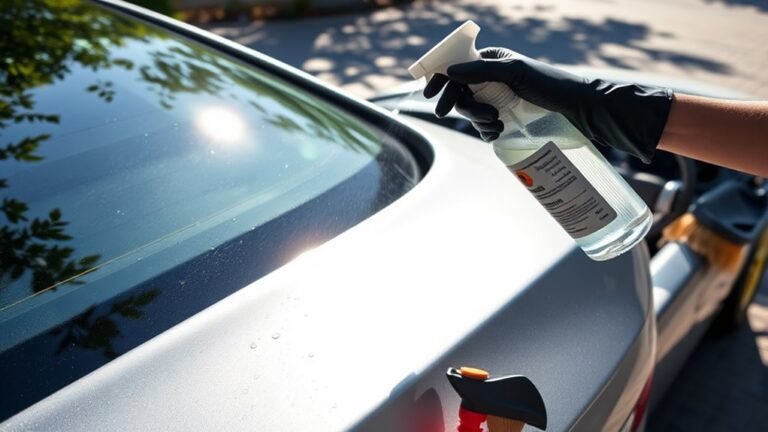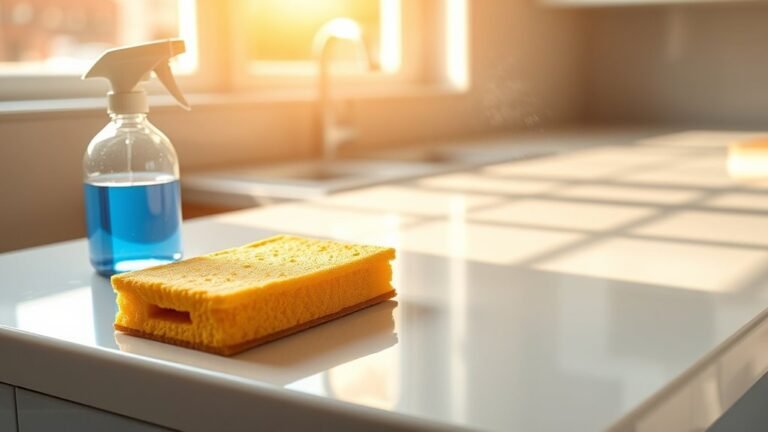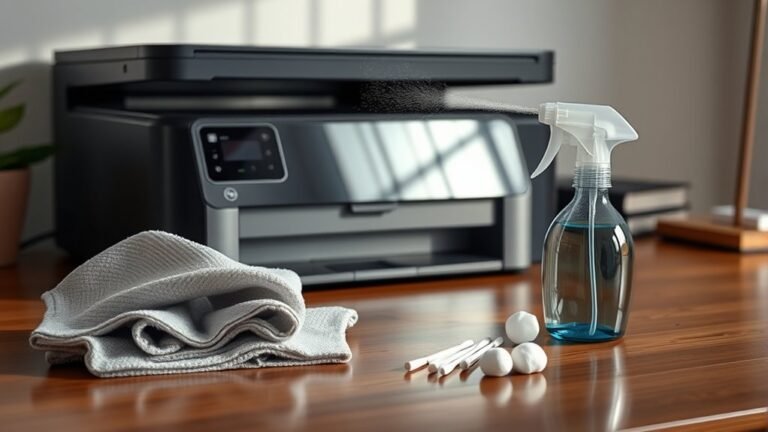Cleaning Mistakes That Damage Your Pet Mess
You’re likely making cleaning mistakes that worsen your pet mess rather than fix it. Using harsh chemicals or ammonia can irritate your pet and leave harmful residues. Scrubbing too hard can set stains deeper and damage fabrics. Waiting to clean spills lets odors and stains set, and scented cleaners may attract your pet back. Over-wetting surfaces causes mold and lingering smells. If you want to keep your home fresh and safe for pets, there’s more you should know.
Using Harsh Chemical Cleaners on Pet Stains

Although it might seem like a quick fix, using harsh chemical cleaners on pet stains can actually cause more harm than good. When you rely on strong chemicals, they often leave behind chemical residue that’s invisible to the eye but dangerous to your pet’s health. Your furry friend might lick or walk on treated surfaces, unknowingly ingesting toxins that can lead to irritation, allergies, or worse. Instead of risking their well-being, you can choose safer, pet-friendly cleaning solutions that break down stains without compromising freedom or safety. Protecting your pet means being mindful of what you use around them. Cleaning should free you and your pet, not trap you both in a cycle of harmful exposure and health risks.
Scrubbing Pet Messes Too Vigorously
When you scrub pet messes too hard, you risk damaging your floors or carpets and pushing stains deeper. Instead, try gentle cleaning techniques that lift stains without harming surfaces. Using soft cloths and mild cleaners can keep both your home and pet safe.
Effects of Over-Scrubbing
If you scrub pet messes too hard, you risk pushing stains deeper into fabrics or carpets, making them harder to remove. Over scrubbing consequences include fabric damage, color fading, and spreading the mess further. It’s tempting to use aggressive scrubbing techniques, but that often backfires, restricting your freedom to clean effectively. Instead, understanding the balance is key.
| Issue | Cause | Result |
|---|---|---|
| Stain Deepening | Excessive pressure | Harder to remove stains |
| Fabric Wear | Rough scrubbing tools | Damage and thinning |
| Mess Spreading | Vigorous scrubbing | Larger affected area |
Avoid these pitfalls to keep your cleaning efforts truly effective and your pet’s environment fresh without damage.
Gentle Cleaning Alternatives
Since scrubbing too hard can make stains worse, you’ll want to switch to gentler cleaning methods that protect your fabrics and keep pet messes from spreading. Instead of harsh chemicals or vigorous scrubbing, try eco friendly solutions made with natural ingredients. These are tough on stains but kind to your home and the environment. Dab the mess with a soft cloth or sponge soaked in a mixture of water and white vinegar or baking soda. Let it sit briefly, then gently blot to lift the stain without grinding it in. This approach not only preserves your fabrics but also keeps your space fresh without harmful residues. Embracing gentle, natural cleaning gives you freedom from worry and a safer place for your pet.
Ignoring Proper Stain Removal Techniques

Although it might seem easier to scrub away pet stains quickly, ignoring proper stain removal techniques can cause more harm than good. When you rush into cleaning without the right approach, you risk setting the stain deeper or damaging your flooring. Effective stain removal means understanding the type of mess and using appropriate cleaning techniques that won’t harm your surfaces or irritate your pet. You want your home to feel fresh and safe, not restricted by stubborn stains or harsh chemicals. Take the time to apply targeted methods—like blotting before scrubbing or using enzyme-based cleaners designed for pet messes. This way, you maintain your freedom to enjoy a clean, comfortable space without worrying about long-term damage or lingering odors.
Using Ammonia-Based Products Near Pet Areas
When you use ammonia-based products near your pet’s spaces, you might unintentionally create a hazardous environment. Ammonia dangers are real, especially since pets are sensitive to strong odors and fumes that can irritate their respiratory systems. To keep pet safety a priority, avoid using these cleaners around areas where your furry friends eat, sleep, or play. Instead, opt for pet-friendly alternatives that won’t compromise their health or your space’s cleanliness. Remember, your pet depends on you to create a safe, toxin-free environment.
- Ammonia smells can mimic urine, confusing pets and encouraging repeat marking
- Inhalation of ammonia fumes can cause coughing, sneezing, or worse respiratory issues
- Direct contact with ammonia-based cleaners may irritate your pet’s skin and eyes
Choose wisely to protect your pet’s freedom and well-being.
Not Blotting Up Liquids Immediately

If you don’t blot up spills right away, stains can set deep into carpets and fabrics. This makes them much harder to remove and leaves lingering odors that can bother your pet. Acting quickly helps keep your home fresh and safe for your furry friend.
Causes of Stain Setting
Since liquids can quickly soak into fabrics and carpets, not blotting them up immediately allows stains to set deeper, making them harder to remove later. Understanding stain chemistry helps you realize why time is essential—different fabrics absorb liquids at varying rates, affecting how stains form and settle. For example, porous fabric types like cotton absorb stains faster than synthetic ones, causing quicker setting. When you delay, chemical bonds form between the stain and fibers, making removal tough.
Keep these causes of stain setting in mind:
- Absorption speed: Fast absorption means quicker stain setting.
- Fabric type: Natural fibers often trap stains deeper.
- Chemical interaction: Stains chemically bond with fibers over time.
Acting swiftly keeps your freedom to clean effectively and protects your favorite fabrics.
Impact on Odor Removal
Although it might seem minor, not blotting up liquids right away can seriously affect how well you remove odors later. When you let spills sit, they soak deeper, making it harder for odor absorption techniques to work effectively. You want to act fast, pressing a clean cloth to soak up as much as possible before the mess settles in. This quick step is essential for any natural deodorizing methods to be successful since lingering moisture fuels bacteria that cause those stubborn smells. By taking immediate action, you free yourself from prolonged odor battles and reduce reliance on harsh chemicals. Remember, the secret to fresh spaces is simple: blot fast, then treat with gentle, natural solutions that respect both your home and your pet’s health.
Applying Cleaners Without Testing First
Before using any cleaning product around your pet, you should always test it on a small, hidden area first. This simple step guarantees cleaner compatibility with your surfaces and helps prevent damage or discoloration. Skipping surface testing can lead to costly repairs and expose your pet to harsh chemicals. Protect your freedom to enjoy a safe, clean home by taking this quick precaution.
Always test cleaning products on a hidden spot first to protect your home and keep pets safe.
Remember to:
- Check the cleaner’s label for pet-safe ingredients.
- Apply a small amount to an inconspicuous spot and wait 10 minutes.
- Observe for any adverse reactions like fading, bubbling, or residue.
Over-Wetting Carpets and Upholstery
A common mistake pet owners make is over-wetting carpets and upholstery during cleaning. When you soak these areas, you risk trapping moisture deep inside fibers, which slows carpet drying and creates a breeding ground for mold and mildew. This not only damages your flooring and furniture but also harms your pet’s health by promoting allergens. To maintain freedom in your home and keep your space fresh, use just enough cleaner to treat the spot and blot up excess moisture quickly. Regular upholstery maintenance, including gentle cleaning and prompt drying, helps preserve fabric integrity and prevents long-term damage. Remember, controlling moisture is key—don’t let your cleaning efforts backfire by over-wetting and compromising your home’s comfort and your pet’s safety.
Neglecting to Neutralize Pet Odors
If you don’t neutralize pet odors properly, you’re only masking the problem instead of solving it. Simply covering up smells with generic cleaners won’t give you the freedom of a truly fresh home. To break free from lingering pet odors, you need to use effective odor neutralizing products designed specifically for pet messes. These products tackle smells at their source, providing long lasting freshness instead of temporary relief.
To guarantee you’re on the right track, remember to:
- Choose enzymatic cleaners that break down odor-causing molecules
- Apply odor neutralizing products thoroughly on all affected areas
- Allow surfaces to dry completely to prevent mold and lingering smells
Using Scented Cleaners That Attract Pets Back
Though scented cleaners might seem like a good idea to freshen your home, they can actually draw your pets back to the very spots you’re trying to clean. Many scented attractants in these products mimic smells that appeal to your pet’s natural instincts or preferences, unintentionally encouraging them to mark or investigate the area again. If you want to keep your space truly fresh and free from repeat messes, it’s essential to choose unscented or pet-safe cleaners. Paying attention to your pet’s unique preferences helps you avoid scents that might lure them back. Freedom means creating a clean environment without trapping your pet in cycles of unwanted behavior, so be mindful of the cleaners you use and keep your home inviting for everyone, pets included.
Failing to Clean Pet Messes Promptly
When you don’t clean up pet messes right away, stains and odors can set in, making them much harder to remove later. Delayed cleaning not only damages your home but can also affect your pet’s behavior. Your furry friend might return to the same spot if the scent lingers, reinforcing unwanted habits. To maintain a fresh space and promote good pet behavior, tackle messes immediately. Here’s what you can do:
- Use enzymatic cleaners to break down stains and odors effectively.
- Blot spills quickly to prevent deeper absorption into carpets or furniture.
- Keep cleaning supplies handy for fast response times.
Frequently Asked Questions
How Often Should I Deep Clean My Pet’s Bedding?
You should deep clean your pet’s bedding materials at least once a week to keep things fresh and hygienic. Depending on your pet’s activity level and messiness, you might need to adjust the cleaning frequency. If your furry friend loves outdoor adventures or has allergies, more frequent washing helps. Sticking to a regular schedule lets you enjoy freedom from odors and allergens, making your home comfy for both you and your pet.
Can Natural Cleaners Be as Effective as Chemical Ones on Pet Stains?
Did you know that 70% of pet owners prefer natural cleaner effectiveness for tough stains? When comparing chemical cleaner comparisons, natural options often work just as well for pet stains without harsh fumes or residues. You’ll find they’re gentler on fabrics and safer around your furry friends, giving you freedom from worries about toxins. So, you can confidently choose natural cleaners and keep your home fresh and safe without compromising on power.
What Are the Best Tools for Cleaning Pet Hair From Furniture?
If you’re tackling pet hair on furniture, lint rollers are a lifesaver—they quickly grab hair without fuss. You’ll also want to use vacuum attachments designed for upholstery; they reach deep into fabric and crevices, making cleanup effortless. Combining these tools gives you the freedom to keep your space hair-free without battling stubborn fur. With the right gear, you’ll breeze through cleaning and enjoy your pet-friendly home without limits.
How Do I Prevent My Pet From Marking the Same Spot Again?
They say, “An ounce of prevention is worth a pound of cure.” To stop your pet from marking the same spot again, focus on thorough scent elimination—you’ve got to remove every trace of their marking behavior scent. Use enzymatic cleaners specifically designed for pet messes. Also, consider giving your pet more freedom by providing plenty of outdoor time and positive reinforcement when they mark in appropriate places. This way, you’ll keep your space fresh and your pet happy.
Are Enzymatic Cleaners Safe for All Types of Flooring?
You’ll find enzymatic cleaners pretty effective in tackling pet messes because they break down organic stains and odors. However, not all flooring materials react the same way. While they’re generally safe for sealed hardwood, tile, and laminate, you should avoid using them on unsealed wood or delicate surfaces, as they might cause damage. To enjoy freedom in cleaning, always test a small area first, ensuring the product works well without harming your floors.






